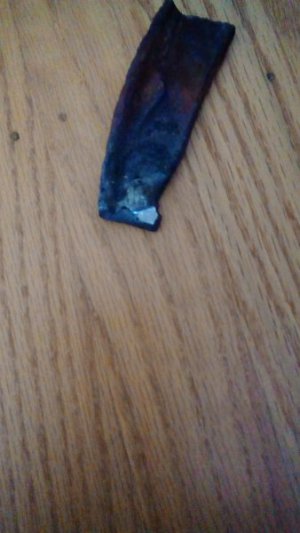I had the oxy-propane torch out for some brazing, so I tried some cast iron welding. I used a hacksaw to cut out a rod, and I mixed cast iron flux with filings. It works, but takes a lot of heat. The piece was air cooled, and it was hard, but not too hard to cut with a file, as evident from the photo.
-
Welcome back Guest! Did you know you can mentor other members here at H-M? If not, please check out our Relaunch of Hobby Machinist Mentoring Program!
You are using an out of date browser. It may not display this or other websites correctly.
You should upgrade or use an alternative browser.
You should upgrade or use an alternative browser.
Welding cast iron (experiment)
- Thread starter ericc
- Start date
- Joined
- Jun 7, 2013
- Messages
- 10,071
CI flux mixed with filings of what?
It is mixed with cast iron filings. I have plenty of these and not much filler, so I figured that this would make it go farther. It seems that the flux helps the filler wet in better with less porosity. The photo is not too good, but there is a tiny (insignificant) bit of porosity at the end of the bead. The test was done on a rusty piece of cast iron I found from a broken street drain. I was just curious if it would work with oxy-propane, since steel welding does not. Well, it does, and the flux helps.
- Joined
- Jun 7, 2013
- Messages
- 10,071
The purpose of a flux is to lower the melting temperature of the impurities on and in the object being welded. If you would like to weld cast iron effectively and nicely, first grind off rust and scale from the surface being welded, and further do yourself a favor and buy some Eutectic cast iron welding rod that is flux coated, the stuff is like magic, instead of working with a big pasty mass, as when using the square cast rods commonly available, Eutectic's rod melts at a somewhat lower temp. and can be added a drop at a time, and flows out much easier than the regular type rod. Oxy/propane is not really practical for welding much of anything, the temp is low, and the flame is diffuse, not concentrated, as is oxy / acetylene.
Personally, for most work, I prefer brazing for cast iron repair, it takes place at a lower temperature, material is more easily added, and there is less chance of cracking, and less need for extensive pre heat. Cast iron can also be welded by arc welding or Tig, using nickel rod, but the issue of preheat and subsequent post weld cracking are still there; once cracked, very hard to fix.
Personally, for most work, I prefer brazing for cast iron repair, it takes place at a lower temperature, material is more easily added, and there is less chance of cracking, and less need for extensive pre heat. Cast iron can also be welded by arc welding or Tig, using nickel rod, but the issue of preheat and subsequent post weld cracking are still there; once cracked, very hard to fix.
In the days when welding cast iron was a necessary skill,the flux generally used was fine white sand.........the sand melts and protects the iron,and also provides needed silicon to the weld,which is burnt out in the welding process.....A high silicon iron was used as filler rod.too.
Very interesting. I didn't know that the silicon in the sand was available for boosting the fluidity. I could have used more fluidity, but was not ready to drop $28 on 4 rods from Valley Forge and Welding, even though it is a great shop. Now that I know it works, I'm more motivated to buy them.
Ive got a million piston rings ,all WW2 vintage,so they are cast iron......strangeley enough ,ive sold some sets for things like Wright 2300s.........but I very much doubt the buyers have motors to reco........out in the colonies ,we have to make do with what we have,and that aint very much.


